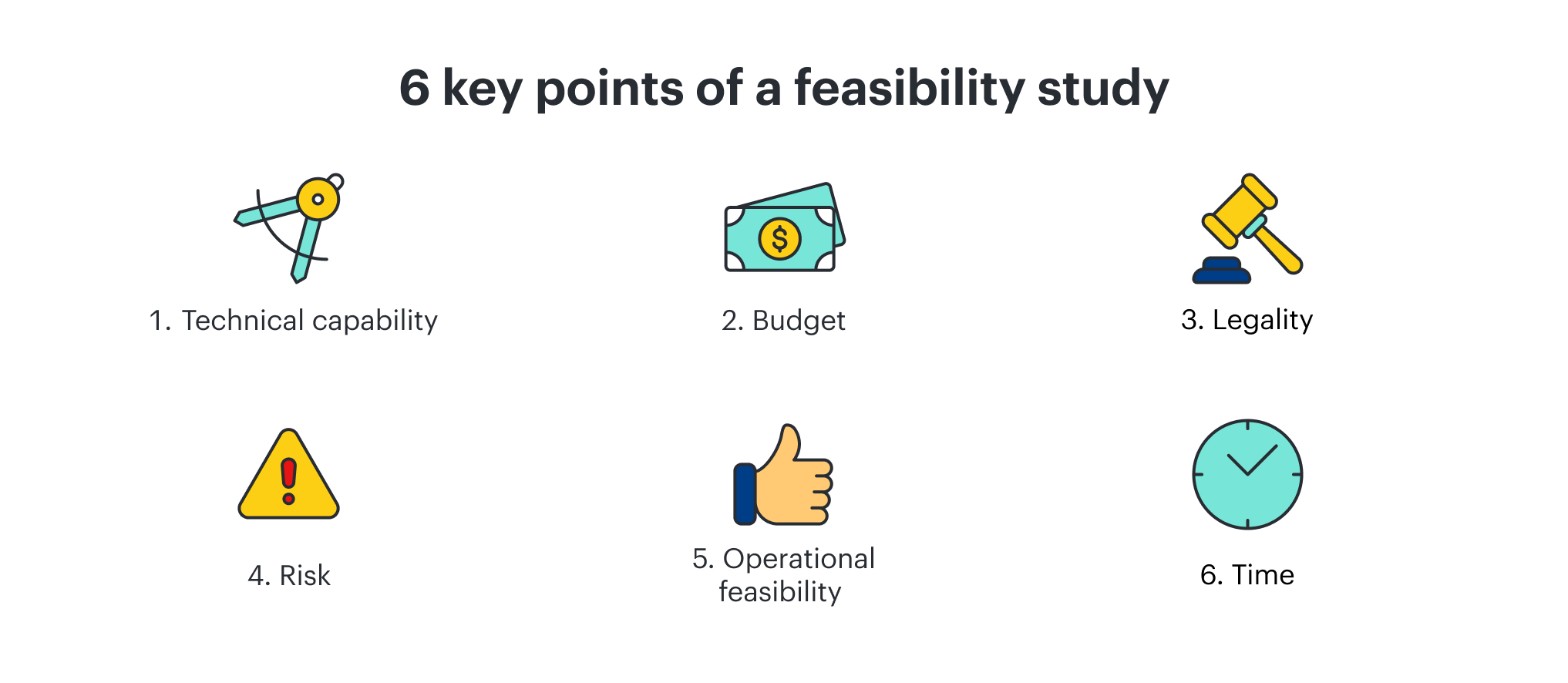
What is a feasibility study?
Reading time: about 7 min
A feasibility study helps you and your team foresee potential challenges, prepare for risks, and weigh the benefits of a project. A high-quality feasibility study can prevent problems and help your organization reduce the likelihood (and impact of) bad project planning.
Project managers benefit from feasibility studies but so does the rest of the team. During implementation, the feasibility study may serve as a reference for mitigating and managing risk.
What is a feasibility study in project management?
Using a feasibility study, organizations review recommended projects and determine how likely it is that the project will be completed successfully. This allows management to choose which projects the business will undertake based on the necessary resources, overall project goals, available market information, and other relevant research. To be successful, the project must make sense in light of business objectives and potential return on investment.
As part of the research and analysis to determine a project’s value and viability, feasibility studies are conducted before project implementation. If your feasibility study is planned and designed well, it will thoroughly investigate any risks that are possible outcomes of your project.
After your feasibility study, you can confidently implement a project plan knowing that you’ve fully accounted for potential issues and that your plan is aligned with your goals. If the feasibility study doesn’t result in a positive outcome for the project, then your team may need to reconsider basic assumptions of your project plan or revisit your business objectives.
A feasibility study follows a set process with seven steps guiding research and analysis. Ultimately, the project ends with a decision for or against completing the project.
Key points of a feasibility study
Feasibility studies are structured in such a way as to systematically address various aspects of your project and your organization’s capabilities, such as technical, operational, and financial resources and risks associated with your project.
A feasibility study can cover many different areas or can be limited to a single topic. For instance, you can develop a feasibility study that includes scheduling, operational, and budgetary analysis. Not every project needs every type of feasibility study, but you should be as thorough as possible in your analysis, since feasibility studies protect your team and your project.

1. Technical capability
By taking a close look at your technical capabilities, you can ensure your organization’s existing resources are enough to meet your project’s needs. Your team should be able to bring your project’s core ideas to fruition. If not, then this part of the feasibility study may uncover a need for greater technical resources or may mean your organization should reconsider the overall project.
Areas to consider include:
- Labor: Is the right team available? Do you need to hire anyone else to make the project a success? Are any key personnel planning to take a vacation, move to another role, or take on a project that may compete with this project in terms of personal focus and bandwidth?
- Logistics: Are there logistical challenges internally or externally (with a supplier or customer) to consider?
- Technology: Does your company have the technology to complete the project? Do you need to develop or obtain additional technology first?
- Materials: Do you have the materials you need to complete the work? Are any materials difficult to obtain, increasing in price, or reliant on supplier capabilities?
Moving forward, your technical feasibility planning can help you with other areas of your study, such as labor budgeting.
2. Budget
Every project should have a sufficient budget in order to stay feasible. Funding your project means making sure your project is economically viable. A cost/benefit analysis can bring the full value of your project directly into view.
A budget feasibility analysis can use techniques such as:
- Forecasting: Based on historical data or information from similar projects, your team can identify trends. This may involve, for instance, changes in labor costs during your project’s implementation.
- Estimation: Using a graph to visualize data, you can estimate budgetary changes.
These numbers aren’t final, but they should give you a good idea of what to expect during implementation and whether or not your project’s budget is sufficient.

3. Legality
With most projects, legal issues are an important consideration. Staying in compliance should be a key emphasis throughout your project. Otherwise, legal requirement conflicts could jeopardize your plans.
Here are a few general areas legal feasibility considers:
- Legal readiness: Is your organization fully prepared for any potential legal implications of this project?
- Main legal issues: What are the primary legal issues that affect your project? Has your organization fully explored and prepared for these issues in a similar project? For instance, have licensing and patent issues been fully accounted for?
- Stakeholder impact: Does the project potentially affect stakeholders in ways that could create conflict or impact contractual agreements and responsibilities?
Your legal feasibility assessment determines how to proceed with the project while adhering fully to legal requirements.
4. Risk
Risks can be an inherent part of doing business, but uncovering risk and looking for opportunities to address it can enable your team to improve your likelihood of success.
Approach risk in your feasibility report with these possible reactions in mind:
- Avoid: If you find risks during your feasibility study that could be eliminated completely, then you’ll want to document and explore any strategies you can identify.
- Reduce: Some risks may be reduced so they are less likely to impact your project or so they’ll have less of a negative impact.
- Acceptance: Unavoidable risks that can’t be reduced or eliminated may be accepted. If you accept risk in your project, then you will still likely need a risk management strategy.
Based on your risk assessment within your feasibility study, your team can develop a risk management plan that appropriately addresses risks.
5. Operational feasibility
For this portion of a feasibility study, your team determines whether or not the project meets operational requirements. Does the project meet business needs? To answer this question, you should carefully review the project’s impact on operations:
- Scaling: Does this project allow your organization to scale operations or more effectively manage existing operations?
- Performance: How does the project impact performance? For instance, could the project have an adverse impact on your organization’s ability to operate?
- Customer experience: Does the project impact customer experience? Is this impact potentially positive or negative (or even neutral)?
Based on your findings, your team can address operational impact that could be negative and can explore how positive impact could benefit the organization.
6. Time
Time reflects the scheduling, timing, and start and end of the project in relation to your organization’s other projects and activities. Like other resources, time is finite and must be carefully managed.
- Concurrent projects: Are other projects scheduled at the same time? Could the overlap make it more difficult to complete the project successfully?
- Opportunity windows: Are certain opportunities time-bound? For instance, if your project is only helpful if it’s completed within a year, is the project still worthwhile for your organization?
- Scheduling risks and benefits: Do differences in scheduling confer different risks or benefits on your project? Could a change in timing be beneficial or harmful for your team or for your organization as a whole?
Once you have a thorough understanding of how timing and scheduling impact your project and stakeholders, you can determine if your project plan scheduling requirements need adjustment.

Interested in collaborating with team members on your next feasibility study? Or just want a collaborative space to share your findings? Try Lucidspark.
Learn moreAbout Lucidspark
Lucidspark, a cloud-based virtual whiteboard, is a core component of Lucid Software's Visual Collaboration Suite. This cutting-edge digital canvas brings teams together to brainstorm, collaborate, and consolidate collective thinking into actionable next steps—all in real time. Lucid is proud to serve top businesses around the world, including customers such as Google, GE, and NBC Universal, and 99% of the Fortune 500. Lucid partners with industry leaders, including Google, Atlassian, and Microsoft. Since its founding, Lucid has received numerous awards for its products, business, and workplace culture. For more information, visit lucidspark.com.
Related articles
How to track your project budgets
With careful project budget tracking, teams can make better informed decisions and mitigate financial risks.
